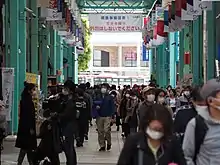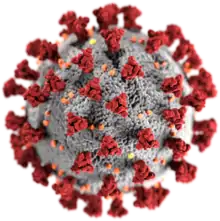Pandemic fatigue
Pandemic fatigue is the state of being worn out by recommended precautions and restrictions relating to a pandemic, often due to the length of the restrictions and lack of activities for one to engage in, resulting in boredom, depression, and other issues, thereby leading one to abandoning these precautions and risk catching the disease.[1] Pandemic fatigue can be responsible for an increased number of cases.[2]

Influences
Social norms
Social norms can have an effect on pandemic fatigue.[3]
Response
Epidemiologist Julia Marcus wrote that indefinite abstention from all social contact was not a sustainable way to contain a pandemic. Drawing from lessons in HIV prevention, she advised a principle of harm reduction rather than an "all-or-nothing approach" in controlling the COVID-19 pandemic.[4]
COVID-19 pandemic
| Part of a series on the |
| COVID-19 pandemic |
|---|
 |
|
|
|
COVID fatigue is the state of being worn out about the precautionary measures and the threat of COVID-19. Anxiety from the threat of losing economic security and catching the disease both play a part in the feeling of fatigue in people. COVID fatigue has caused people to not follow precautionary guidelines, increasing their risk of catching the virus.[5] Many people are tired of the lockdowns, and not having a normal routine.[6][7] Higher levels of alcohol and drug use also contribute to the feeling of tiredness.[8]
As lockdowns were lifted in many parts of the world, a lot of people started to ignore stay-at-home orders. People went to bars and restaurants, ultimately causing the disease to spread faster.[9]
Exercise, talking, and lowering consumption of media are ways to fight against the feeling of fatigue.[10][11]
See also
References
- Barnett, Stacy Meichtry, Joanna Sugden and Andrew (October 26, 2020). "Pandemic Fatigue Is Real—And It's Spreading" – via www.wsj.com.
- "U.S. Surgeon General Blames 'Pandemic Fatigue' For Recent COVID-19 Surge". NPR.org.
- https://www.cnn.com/cnn/2020/11/12/health/pandemic-fatigue-wellness-partner/index.html
- Marcus, Julia (11 May 2020). "Quarantine Fatigue Is Real". The Atlantic. Retrieved 15 November 2020.
- "'COVID Fatigue' and How to Fight It | AMITA Health Blog". www.amitahealth.org. Retrieved 2020-11-25.
- Koplon, Savannah. "How to overcome COVID-19 fatigue". UAB News. Retrieved 2020-11-25.
- Marketing, UC Davis Health, Public Affairs and. ""COVID fatigue" is hitting hard. Fighting it is hard, too, says UC Davis Health psychologist". health.ucdavis.edu. Retrieved 2020-11-25.
- Authority, University of Wisconsin Hospitals and Clinics. "Managing COVID Fatigue is Crucial to Our Health and Wellbeing During the Pandemic". UW Health. Retrieved 2020-11-25.
- "How to fight 'Covid fatigue' as America heads for a deadly winter". the Guardian. 2020-11-22. Retrieved 2020-11-25.
- Medicine, Northwestern. "Do You Have COVID-19 Caution Fatigue?". Northwestern Medicine. Retrieved 2020-11-25.
- "How to combat 'COVID fatigue': Medical experts on what works -- and doesn't". ABC News. Retrieved 2020-11-25.